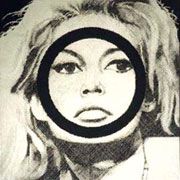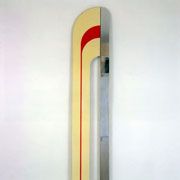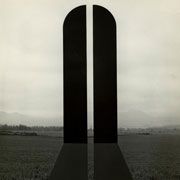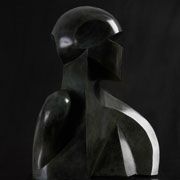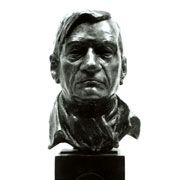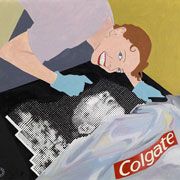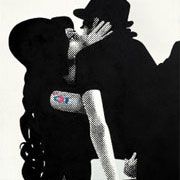
Catalogue Raisonné. Starlet I
Search the Catalogue
Starlet I
Catalogue No. 13
Artist's CR 010
1963
New York
Oil on canvas
50 x 20 inches / 127 x 51 cm
Collection: Private collection
- (Richard Feigen Gallery, New York)
- Collection of Julian Levy
- Sold at auction by Tajan Auctioneers, Rue des Mathurins, Paris, 5 October 2004, Lot 125
- Private collection
- New Images, Richard Feigen Gallery, New York, NY, 1964
- British Pop, Museo de Bellas Artes de Bilbao, Bilbao, 2005–6
- Source and Stimulus: Polke, Lichtenstein, Laing, Lévy Gorvy, London, London, 2018
- Gerald Laing, 'Aspen Notebook', unpublished manuscript, 1966
- Tribute to Julien Levy, 5, 6, 7 October 2004, 2004, sale catalogue, Tajan, Paris, 2004
- Marco Livingstone, British Pop, exhibition catalogue, Museo de Bellas Artes de Bilbao, 2005–6
I painted Starlet I during the summer of 1963 in Robert Indiana’s loft on Coenties Slip at the southern end on Manhattan. Coenties Slip is now a wind-swept concrete plaza, but then it was surrounded by mid-nineteenth century warehouses and one could sense the strong maritime history in the street names and in the architecture. It was an area favoured by artists long before Soho became fashionable. In the immediate neighbourhood lived Rauschenberg, Youngerman, Agnes Martin and James Rosenquist.
I was still a student at that time, and on a summer visit to New York; Bob gave me a job as his studio assistant, and space to do my own work. In London I had already made a number of paintings (Brigitte Bardot, Anna Karina, etc.) but since these were based on newspaper photographs they were monochrome. In New York I first began to used colour in my paintings, deriving them from such sources as Life Magazine, and emulating Bob’s meticulous technique in applying the colour, so that it became reminiscent of the effect produced by commercial silkscreen printing.
British Pop, Gerald Laing, (quoted in), exh. cat., Museo de Bellas Artes de Bilbao, 2005, p.435
The painting of mine which is in the Julien Levy Estate is entitled Starlet I. It is in oil paint on canvas and is an early and first class example of a painting from my Pop Art period which extended only from 1962–1965.
I made this painting in Robert Indiana’s loft on Coenties Slip in Manhattan during the summer of 1963. At the time I was still a student at St. Martin’s School of Art in London, but I spent that summer in New York working for Indiana and he gave me space to do my own painting as well.
Like all my paintings at that time, it is a painting of a photographic advertisement, not of reality.
The source was a magazine ad; the technique refers to half-tone printing (the black and white area) and cheap commercial silkscreen printing (the coloured area).
It was sold to Julien Levy by my dealer Richard Feigen…I later used Starlet I as a source for one of the images in my portfolio of silkscreen prints entitled Baby Baby Wild Things which I published in 1968.
Tribute to Julien Levy, Gerald Laing, sale catalogue, 5, 6, 7 October, Tajan, Paris, 2004
These paintings [Starlet I and Starlet II], the precursors of a series of figure studies, are more accomplished solutions of the same problems which were posed earlier in that first half-tone painting, Lolita Through the Keyhole. They combine a more methodical and confident use of dots combined with the area of flat colour which were present from Navy Pilot onwards. The spacial ambiguity of the flat colour in conjunction with the half-tone areas seems more marked where the subject is a news-naked figure.
It is interesting to note that these first figure-paintings were done at a time when I was dutifully, as part of my academic training, daily during term time, painting from the nude model. Discoveries made while executing these purely ‘academic’ studies were of course of enormous value when approachhing the half-tone figures.
Starlets I and II were produced at a time of near-monastic seclusion in N.Y., partially self-inflicted and partially per force. They are in fact extremely sensual in both conception and, more particularly, in execution, in spite of the tidy mass-image sexuality with which they deal. The brisk sanitary perfection of the young girls is in some way echoed by the organic technique; the organic body is formalised in this way. Also, just as the pilot and driver are formalised by their accoutrements, so are these girls formal images; chosen as a type and wearing their uniform of nudity which displays the uniformity of their young bodies.
'Aspen Notebook', Gerald Laing, unpublished manuscript, 1966
- Starlet

